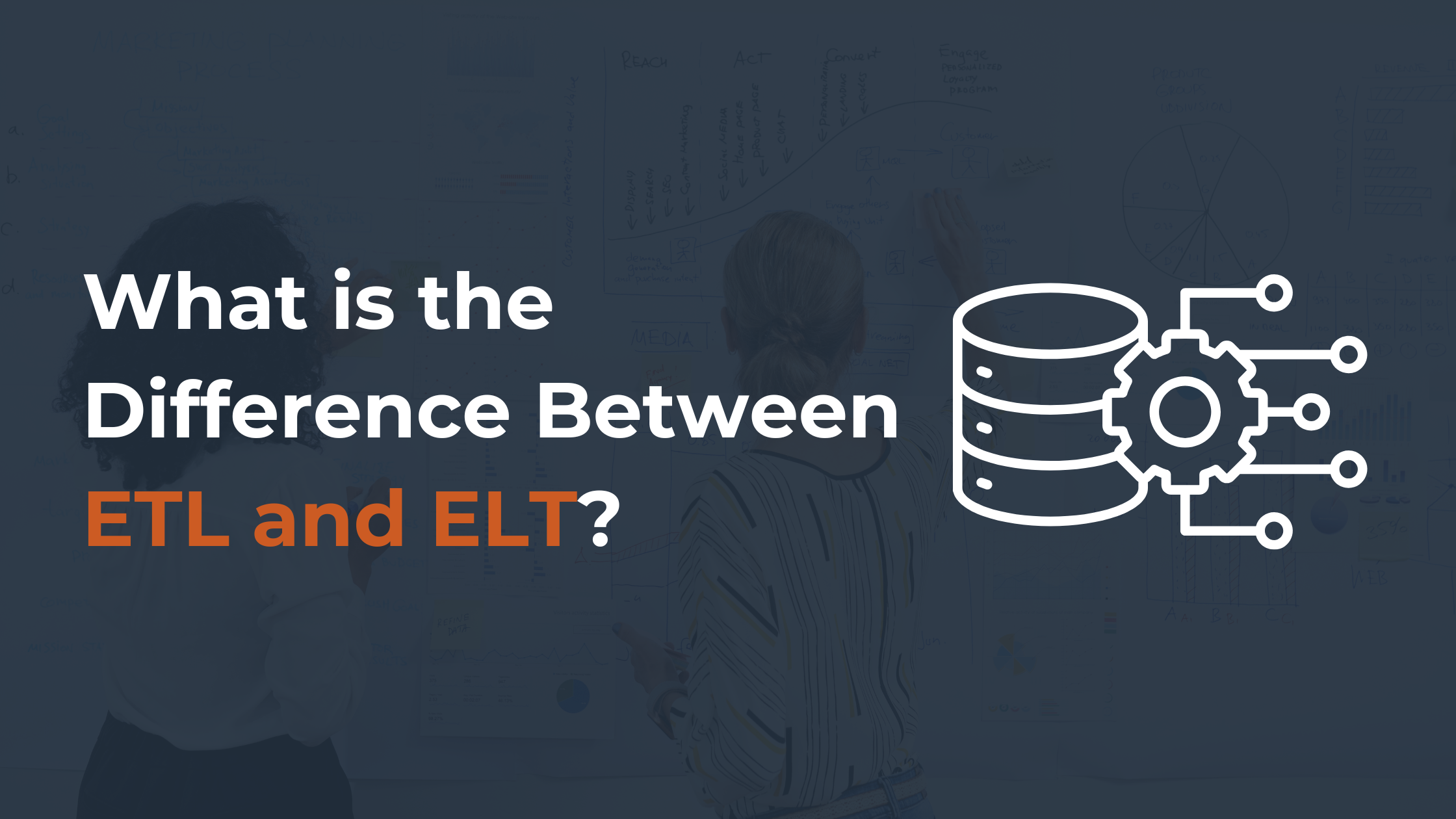- ETL: Extracts data, transforms it in a staging area (for cleansing, structuring, and data quality enforcement), then loads prepared data into a warehouse.
- ELT: Extracts data, loads raw data directly into a data lake or cloud warehouse, then transforms it as needed using in-database compute.
Use Cases:
- ETL fits regulated environments or legacy systems where pre-load control and validation are vital.
- ELT suits cloud-native, big‑data scenarios requiring speed and schema‑on‑read flexibility.
Keep reading to compare two data integration approaches and decide which one is more suitable for you!
Table of Content
What is ETL (Extract, Transform, Load)?

ETL stands for Extract, Transform, Load — a foundational data integration process that helps businesses move and reformat data between systems. Whether you're consolidating customer records, syncing marketing and sales data, or powering advanced analytics, ETL ensures your information flows correctly, consistently, and cleanly.
It’s a behind-the-scenes process, but it plays a critical role in making sure the data you rely on is not just available, but trustworthy, usable, and ready to drive decisions.
Understanding the ETL Process
Here’s how it works, step by step:
- Extract: Data is pulled from one or more source systems (this could be your CRM, ERP, web analytics platform, or even spreadsheets).
- Transform: Data is cleaned, standardized, enriched, and reformatted to ensure consistency across systems. It means converting date formats, merging duplicate records, or mapping fields to new structures.
- Load: The modified data is subsequently transferred to a final destination, such as a data warehouse, analytics tool, or another CRM.
Common Use Cases for ETL
At SyncMatters, we see ETL in action across a wide range of RevOps and data strategies. Some of the most common use cases include:
- CRM Migrations: Moving data from one CRM to another without losing relationships or insights.
- Marketing-Sales Alignment: Syncing campaign engagement data from marketing platforms into sales dashboards.
- Analytics and Reporting: Consolidating data from multiple systems into a centralized warehouse like Snowflake for advanced analysis.
- Data Hygiene: Standardizing and cleaning records to ensure reliable automation and segmentation.
- Recurring Syncs Across Tools: Keeping multiple platforms in sync (daily or real-time) without manual exports or inconsistent imports.
In short, ETL is the engine that powers modern data integration. When configured properly, it enables smarter decisions, automation, and improved business outcomes.
What is ELT (Extract, Load, Transform)?

ELT stands for Extract, Load, Transform, and represents a modern approach to data integration that inverts the traditional ETL process. Instead of transforming data before it’s loaded, ELT pushes raw data directly into a data warehouse first, then transforms it inside that environment.
Why does this matter? Because ELT is purpose-built for today’s scalable, cloud-based ecosystems like Snowflake, BigQuery, or Redshift. This method takes advantage of the vast processing capabilities of modern data warehouses, which are designed to change large amounts of data at scale.
Understanding the ELT Process
Let’s break down use cases of ELT in our ELT vs ETL comparison:
- Extract: Just like ETL, the process begins by pulling raw data from your source systems — CRMs, ERPs, marketing tools, or even APIs.
- Load: Rather than modifying the data first, it is loaded directly into your centralized storage (typically a cloud data warehouse).
- Transform: Once in the warehouse, the data is shaped, cleaned, and enriched, often using SQL or transformation tools, based on the use case.
Common Use Cases for ELT
ELT is quickly becoming the go-to strategy for data-driven teams who need flexibility, scalability, and faster time-to-insight. Here’s where it shines:
- Advanced Analytics & BI: Load everything into a warehouse like Snowflake, then use SQL-based transformations to power dashboards in tools like Looker or Power BI.
- Data Sharing & Collaboration: ELT works exceptionally well when multiple departments or partners need access to raw data in real time, with custom transformations applied as needed.
- Cloud-Native Workflows: If your tech stack is built around cloud-first platforms, ELT minimizes bottlenecks and accelerates delivery.
- Event Streaming and IoT: ELT enables you to collect high-volume, unstructured data and refine it on demand inside the warehouse.
- Marketing Attribution & Funnel Analysis: Bring in raw data from dozens of channels, then build unified views and attribution models within the warehouse.
Let`s decide which approach to choose: ETL or ELT?
ETL vs ELT: Key Differences

Understanding the distinction between ETL (Extract, Transform, Load) and ELT (Extract, Load, Transform) is important for organizations choosing the right data pipeline for their needs. While both processes move data from source systems to a destination, they differ in how, when, and where data is transformed. Here's a deeper look at the difference between ETL and ELT:
Data Flow Process
ETL extracts data from the source, transforms it into the necessary format or structure, and then loads it into the destination system. The transformation occurs outside of the target environment, typically on a dedicated ETL server or tool.
In contrast, ELT reverses the last two steps: data is extracted and loaded as-is into the destination (typically a modern cloud data warehouse), and the transformation happens within that environment using its compute capabilities.
Transformation Timing
ETL vs ELT data processing approaches differ mainly in where and when data transformation occurs during the integration pipeline. ETL performs transformations before loading the data. This approach is beneficial when the target system has limited processing capacity or when data requires cleaning and validation before being ingested.
ELT, on the other hand, waits until the data is loaded before performing any alteration. This allows raw data to be stored quickly, giving you more options for exploratory analysis and schema-on-read approaches.
System Requirements
ETL requires intermediate processing infrastructure capable of handling complex transformations. It often involves maintaining and scaling separate transformation servers.
ELT depends heavily on the compute power of modern cloud data platforms, making it ideal for cloud-first or hybrid architectures.
Scalability
When comparing ETL versus ELT scalability, ETL systems may face limitations as data volumes grow, particularly if the transformation engine is not easily scalable.
ELT scales more naturally with cloud-native data warehouses, which are built to handle high volumes of semi-structured and structured data with compute features.
Speed and Performance
In ETL, the transformation step can slow down the pipeline, especially when large datasets are processed outside the warehouse.
ELT benefits from the high-speed computing and parallel processing of cloud data platforms, often resulting in faster ingestion and transformation for massive datasets.
Complexity
ETL processes tend to be more complex to manage due to their reliance on multiple moving parts — extract engines, transform logic outside the data platform, and loading tools.
ELT simplifies architecture by centralizing data processing within the data warehouse, though writing optimized SQL-based transformations requires technical expertise.
Storage Usage
ETL reduces storage load on the destination by transforming data before it arrives — only clean, structured data is stored.
ELT requires extra storage since raw data is ingested and stored before being transformed. However, modern cloud storage costs are relatively low, making this tradeoff acceptable for many organizations.
Data Volume Handling
ETL is better suited to smaller or medium-sized datasets, where pre-processing before ingestion helps ensure data quality and consistency.
ELT shines with large volumes of diverse data, especially when rapid ingestion is a priority and transformation logic can evolve over time.
Tool Compatibility
ETL tools are often standalone solutions like Informatica, Talend, or SSIS, integrated with legacy systems and on-premise environments.
ELT workflows are usually supported by modern data orchestration tools (e.g., dbt, Airflow) and integrate natively with cloud data platforms, supporting modular, SQL-based development.
The decision between ETL and ELT is based on your current infrastructure, performance needs, and data strategy. While ETL remains critical for certain use cases, ELT is becoming the preferred approach for modern, scalable, cloud-first data ecosystems.
Here is an ETL vs ELT comparison table:
|
Aspect |
ETL (Extract, Transform, Load) |
ELT (Extract, Load, Transform) |
|
Data Flow Process |
Extract → Transform → Load (transformation happens before loading) |
Extract → Load → Transform (transformation happens after loading) |
|
Transformation Timing |
Pre-load; data is cleaned and formatted before entering the target system |
Post-load; raw data is transformed within the data warehouse |
|
System Requirements |
Requires a separate transformation engine or middleware outside the destination |
Leverages the compute power of modern cloud data platforms |
|
Scalability |
Limited by the processing capacity of external ETL tools and infrastructure |
Easily scalable through cloud-native, elastic compute environments |
|
Speed and Performance |
Can be slower due to transformation bottlenecks outside the warehouse |
Faster with large datasets; cloud platforms handle processing in parallel |
|
Complexity |
More components to manage (ETL servers, scripts, dependencies) |
Simpler architecture; transformation handled inside the warehouse |
|
Storage Usage |
Stores only transformed/cleaned data in the destination |
Stores raw and transformed data; requires more storage initially |
|
Data Volume Handling |
Better suited for small to medium data volumes |
Optimized for high-volume, high-velocity data environments |
|
Tool Compatibility |
Traditional tools (Informatica, Talend, SSIS, etc.) |
Modern tools (dbt, Airflow, Fivetran, cloud-native services like BigQuery, Snowflake, etc.) |
ETL vs ELT: Pros and Cons
Choosing between ETL (Extract, Transform, Load) and ELT (Extract, Load, Transform) often comes down to a tradeoff between control, performance, and architectural needs. Both provide the same basic function of transporting and preparing data for analysis, but they are tailored to distinct use cases and technical contexts. Let’s explore ETL vs ELT pros and cons.
Advantages of ETL
1. Data Quality Assurance Before Loading
ETL operations are used to transform and clean data before it is put into the destination system. This ensures only validated, structured data is stored, reducing the risk of polluting analytics environments with errors or inconsistencies.
2. Ideal for Legacy Systems
ETL is well-suited to traditional on-premise databases and enterprise systems. It integrates with long-established data warehousing environments that may not support in-database transformation.
3. Strong Governance and Compliance Control
Because data is transformed before storage, ETL enables stricter control over what gets loaded. This can help organizations meet compliance or data privacy regulations by filtering out sensitive or unnecessary data early in the pipeline.
4. Maturity and Tooling Support
ETL has been around for decades, and a wide array of robust tools, documentation, and enterprise support options are available.
Advantages of ELT
1. Faster Ingestion
ELT allows data to be imported into the destination system quickly. This is particularly useful for real time analytics or streaming data use cases.
2. Leverages the Power of Cloud Data Warehouses
Modern cloud platforms like Snowflake, BigQuery, or Redshift are optimized for in-database transformations. ELT takes advantage of its parallel processing and scalability to transform massive datasets quickly.
3. Supports Schema-on-Read Flexibility
By storing raw data upfront, ELT allows analysts and data engineers to define transformations later as needed. This supports agility, iterative analysis, and multiple transformation logic paths without reloading data.
4. Simplified Architecture
With fewer external processing components, ELT workflows are often easier to deploy, maintain, and scale, especially in cloud-native environments.
Challenges and Limitations of Each Approach
ETL Challenges
- Performance Bottlenecks: External transformation engines may slow down processing as data volumes grow.
- Rigid Data Modeling: ETL pipelines require predefined schemas and transformation logic before loading, which can reduce agility.
- Resource Intensive: Maintaining dedicated transformation infrastructure adds to operational overhead.
ELT Challenges
- Higher Storage Costs: Storing large volumes of raw data in cloud warehouses can be costly if not managed properly.
- Data Governance Risks: Without careful controls, raw data storage can introduce quality, compliance, and security concerns.
A practical ETL vs ELT example shows how traditional ETL transforms customer data before loading it, while ELT loads raw sales data directly into a cloud warehouse for transformation. Both ETL and ELT have their place in modern data architecture. ETL remains valuable in traditional, compliance-heavy, or batch-processing environments. ELT is becoming the default for agile, scalable, cloud-based analytics. The best choice depends on your specific use case and team capabilities.
ELT vs ETL: Which is Better for Your Business?
The question of ELT vs ETL isn’t about which approach is universally better — it's about which is better for your business. The answer is determined by a variety of criteria, such as your data architecture, business objectives, team competence, and the type of data you handle. Here's how to figure out which strategy best meets your needs. So, ETL vs ELT: which is better?
1. Your Data Infrastructure
If your organization relies on modern, cloud-native data platforms, ELT is likely the better fit. These platforms are optimized for in-database transformations and offer scalable compute power to handle complex workloads. ELT allows you to ingest large datasets quickly and transform them using the cloud’s native processing capabilities.
Conversely, if you're working with legacy systems or traditional on-premise data warehouses, ETL may be more suitable. It ensures that only structured and cleaned data reaches your limited storage environment, which is critical when storage or compute is constrained.
2. Speed vs Control
When comparing ELT vs ETL performance, ELT offers speed and flexibility. You can load data rapidly and define transformation logic later, enabling agile data exploration and iterative development. This is especially beneficial for fast-moving businesses or those experimenting with different analytical models.
ETL, however, offers tighter control. Because transformations occur before loading, you can ensure data quality and consistency upfront. This is important for organizations in highly regulated industries, such as healthcare or finance, where data accuracy and governance are paramount.
3. Team Skillset
If your data engineering team is proficient in SQL and cloud technologies, ELT workflows may empower them to move faster and maintain leaner pipelines. Tools like dbt make ELT more manageable by enabling modular, version-controlled SQL transformations directly in the warehouse.
If your team is more comfortable with traditional ETL tools and prefers graphical interfaces or low-code solutions, ETL might be the better choice, at least in the short term.
4. Use Case and Data Volume
ETL shines in environments where data volumes are moderate and transformations are complex or compliance-driven. It works well when business logic must be enforced before any data touches the warehouse.
ELT is better suited for big data and real-time processing, where ingestion speed, horizontal scaling, and schema flexibility are priorities. It also supports advanced use cases, such as machine learning, where raw historical data is valuable.
5. Cost Considerations
While cloud storage is relatively cheap, the compute required for ELT transformations can add up if not managed properly. ETL can reduce processing costs by offloading work to separate servers before data enters the warehouse. However, it may require a higher upfront investment in integration and infrastructure.
Conclusion: Choosing the Right Data Integration Approach

Let's conclude this ETL vs ELT battle. If your priority is data governance, pre-load validation, and compatibility with legacy systems, ETL remains a reliable and structured choice. It's well-suited for organizations with strict compliance requirements and limited processing power in their target environments.
If your business is cloud-first, fast-moving, and data-driven, ELT offers greater flexibility, scalability, and speed. It enables rapid ingestion, transformation within powerful cloud warehouses, and supports modern analytics workflows and machine learning use cases.
At SyncMatters, we help businesses navigate this decision by providing tailored integration solutions that fit your unique infrastructure and data maturity. The best approach is the one that scales with your needs. With SyncMatters, you don’t have to choose blindly; we help you implement the right strategy, backed by deep platform compatibility and expert guidance.
Frequently Asked Questions
What is the main difference between ETL and ELT?
What is ETL and ELT? They are two common data integration methods. ETL alters data before loading it into the destination, whereas ELT loads raw data first and then transforms it in the target system, which is usually a cloud data warehouse.
Can ETL and ELT be used together?
We know the core ETL and ELT difference, but many businesses use a hybrid approach — ETL for structured, compliance-heavy workflows and ELT for fast, large-scale, cloud-native processing.
How do ETL and ELT impact data security and compliance?
When we compare ELT vs ETL security and compliance, ETL offers more control by filtering or encrypting data before loading. ELT requires careful governance, as raw data is stored first; however, modern warehouses provide robust security features.
What tools support ETL and ELT processes?
ETL tools include Talend, Informatica, and SSIS. ELT tools include dbt, Fivetran, and cloud platforms like Snowflake, BigQuery, and Redshift.




